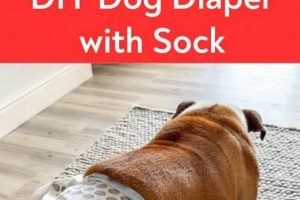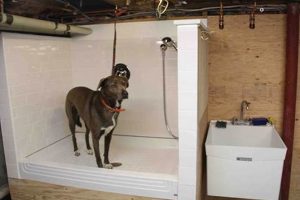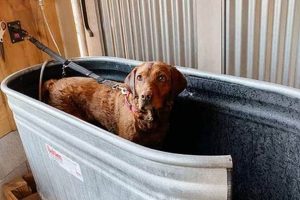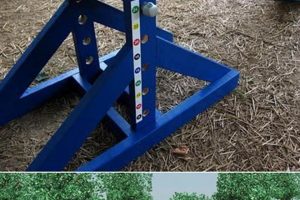The creation of protective footwear for canines through do-it-yourself methods involves designing and constructing coverings for a dog’s paws using readily available materials or repurposed items. This activity allows pet owners to customize foot protection based on their dog’s specific needs and the environmental conditions they encounter. For example, a pet owner might fashion lightweight booties from fabric scraps to shield a dog’s paws from hot pavement during summer walks.
Constructing canine footwear offers several advantages. It protects paws from abrasive surfaces, extreme temperatures, and irritants such as salt and chemicals used in snow removal. Historically, improvised paw protection likely emerged as a solution to address environmental challenges faced by working dogs or those living in harsh climates. By crafting one’s own paw wear, individuals can reduce costs and tailor the fit and design to their pet’s unique morphology, improving comfort and functionality.
The subsequent sections will delve into various methods for creating such footwear, exploring suitable materials, construction techniques, and design considerations to ensure the comfort and safety of the animal wearing them. These will include patterns and recommendations for dogs of varying breeds and sizes.
Essential Considerations for Homemade Canine Footwear
The following guidelines provide critical information to ensure the effective and safe construction of protective coverings for a dog’s paws using do-it-yourself techniques. Careful consideration of these aspects is vital for the well-being of the animal.
Tip 1: Material Selection: Prioritize breathable, durable materials to prevent overheating and withstand wear. Canvas, neoprene, and tightly woven fabrics are suitable options. Avoid materials that can easily trap moisture, which can lead to skin irritation.
Tip 2: Accurate Measurement: Precise measurement of the dog’s paws is crucial for a comfortable and secure fit. Measure the length and width of each paw while the dog is standing, and add a small allowance for movement. Account for any differences in paw size between the front and rear legs.
Tip 3: Secure Fastening: Implement a robust fastening system to keep the footwear securely in place during activity. Adjustable straps with hook-and-loop closures, elastic bands, or a combination thereof are effective. Ensure that the fastening mechanism does not constrict circulation or cause chafing.
Tip 4: Non-Slip Soles: Incorporate non-slip material on the soles to provide traction on various surfaces. Rubberized fabric, textured coatings, or repurposed rubber from items like bicycle inner tubes can enhance grip and prevent slips or falls.
Tip 5: Regular Inspection: Routinely inspect the homemade footwear for signs of wear and tear, such as frayed seams, holes, or loose fastenings. Promptly repair or replace damaged items to maintain their functionality and prevent injury.
Tip 6: Gradual Acclimation: Introduce the footwear to the dog gradually to allow them to adjust to wearing it. Start with short periods indoors and progressively increase the duration and intensity of use. Positive reinforcement, such as treats and praise, can aid in the acclimation process.
Tip 7: Paw Hygiene: Maintain proper paw hygiene to prevent infections and other skin issues. Regularly clean and dry the dog’s paws, especially after exposure to wet or muddy conditions. Monitor for any signs of irritation, redness, or swelling, and consult a veterinarian if necessary.
Adhering to these recommendations promotes the creation of functional and safe paw protection. Focusing on material quality, accurate fit, secure fastening, and paw hygiene minimizes the risk of discomfort or injury to the canine companion.
The concluding section will summarize the critical aspects of constructing and utilizing canine footwear, reinforcing the importance of prioritizing safety and comfort.
1. Material Durability
Material durability represents a critical factor in the successful execution of do-it-yourself canine footwear projects. The longevity and effectiveness of the resulting paw protection are directly proportional to the capacity of the chosen materials to withstand environmental stresses and the rigors of canine activity. Inadequate material strength will result in premature wear and tear, compromising the protective function and necessitating frequent replacement. For example, utilizing thin, easily torn fabrics will render the constructed footwear ineffective against abrasive surfaces like asphalt or gravel, negating the intended benefit of paw protection.
The selection process must therefore prioritize materials demonstrably resistant to abrasion, puncture, and water damage. Canvas, tightly woven nylon, and reinforced neoprene represent viable options, offering a balance of durability and flexibility. Furthermore, seam construction techniques play a crucial role; reinforced stitching and the use of durable thread are essential to prevent separation under stress. The material’s ability to maintain its structural integrity over repeated use, exposure to varying temperatures, and contact with moisture directly influences the economic efficiency and practical value of the do-it-yourself project. Choosing inexpensive, but weak material will cause dog shoes not perform it’s goal and the cost will be doubled.
In conclusion, material durability is not merely a desirable attribute but a fundamental requirement for effective do-it-yourself canine footwear. Prioritizing robust, resilient materials translates to extended product lifespan, enhanced paw protection, and a reduction in the long-term cost associated with replacement or repair. This understanding underscores the need for informed material selection as a cornerstone of successful do-it-yourself canine footwear endeavors.
2. Accurate Sizing
Accurate sizing constitutes a foundational element in the creation of functional and comfortable canine footwear. Within the context of do-it-yourself (DIY) paw protection, neglecting precise measurements invariably leads to ill-fitting products that compromise the dog’s mobility and well-being. Shoes that are too large may slip off during activity, rendering them useless and potentially posing a tripping hazard. Conversely, footwear that is too small can constrict circulation, cause chafing, and lead to discomfort or even injury. The cause-and-effect relationship is evident: imprecise sizing directly results in a reduction in the effectiveness and safety of the homemade footwear. For example, a dog wearing inadequately sized booties during winter walks may still suffer from frostbite due to compromised circulation, despite the intention of providing thermal protection.
The practical significance of understanding accurate sizing is amplified by the inherent variability in canine paw morphology. Different breeds exhibit significant differences in paw size and shape, and individual dogs within the same breed may also display notable variations. Therefore, relying on generic sizing charts or estimations is insufficient. Detailed measurement of each paw, accounting for length and width, is essential for creating a custom fit. The measurement process should ideally be conducted while the dog is standing, as paw dimensions can change slightly when weight-bearing. The application of this understanding directly impacts the functionality and comfort of the paw protection. A properly sized bootie will allow for natural paw movement, distribute pressure evenly, and remain securely in place during activity.
In summary, accurate sizing is paramount to the success of DIY canine footwear projects. This principle ensures functionality, safety, and comfort for the animal. Challenges associated with paw size variability necessitate precise measurements and careful consideration of individual canine morphology. Adherence to accurate sizing practices is not merely a matter of convenience but a fundamental prerequisite for responsible and effective paw protection.
3. Secure Fastenings
Within the realm of do-it-yourself (DIY) canine footwear, secure fastenings represent a critical design element directly influencing the functionality and safety of the final product. Inadequate retention mechanisms can lead to the frequent loss of the footwear during use, negating its intended protective function. For example, a bootie designed to shield a dog’s paws from winter salt becomes useless if it detaches mid-walk due to a poorly designed or improperly secured closure. The connection between secure fastenings and the overall effectiveness of the DIY footwear is, therefore, demonstrably causal: insufficient retention directly results in diminished protection.
The importance of secure fastenings extends beyond mere retention; it also encompasses the prevention of injury and discomfort. Fastening systems that are overly tight can restrict circulation, leading to tissue damage or chafing. Conversely, those that are too loose may allow debris to enter the footwear, causing irritation or abrasion. A practical illustration lies in the design of hiking boots for dogs; a secure, yet adjustable, fastening system is essential to prevent slippage on uneven terrain while avoiding pressure points that could lead to sores. Furthermore, the ease of application and removal must also be considered, especially for dogs with limited mobility or sensitivity to handling. Choosing high-quality, adjustable straps, buckles, or hook-and-loop closures directly contributes to the practicality and user-friendliness of the DIY dog shoes.
In summary, secure fastenings are an indispensable component of effective do-it-yourself canine footwear. The ability of the paw protection to remain securely in place during activity is paramount, while considerations for comfort and the prevention of injury are equally important. Design challenges lie in balancing security with adjustability and ease of use, ultimately ensuring that the homemade footwear fulfills its intended protective function without causing harm or discomfort to the animal. The selection of appropriate materials and fastening mechanisms is therefore critical to the success of the project.
4. Traction Enhancement
The incorporation of traction enhancement into do-it-yourself (DIY) canine footwear is a critical safety and performance consideration. The primary function of dog shoes is often to protect paws from environmental hazards; however, this protection can inadvertently reduce the natural grip a dog relies upon. Smooth surfaces like tile, hardwood floors, or icy sidewalks become hazardous without adequate traction. A direct causal relationship exists: the absence of traction enhancement in DIY dog shoes increases the risk of slips, falls, and subsequent injuries. An example illustrating this point is a dog wearing homemade booties without any grip enhancement on a polished floor; the dogs gait would be compromised, increasing the likelihood of a fall and potential musculoskeletal strain.
Practical application of traction enhancement techniques in DIY dog shoes involves several methods. Applying a textured coating to the sole of the shoe, such as rubber cement or specialized non-slip paint, significantly improves grip. Repurposing materials like old bicycle tires or rubber mats offers a durable and environmentally conscious approach to traction enhancement. The specific choice depends on the intended use; for indoor use, a less aggressive tread may suffice, while outdoor activities necessitate more robust traction. Furthermore, ensuring that the added traction material is securely bonded to the shoe is vital to prevent detachment during use, which could itself pose a safety hazard.
In conclusion, traction enhancement is an indispensable component of effective DIY canine footwear. The creation of dog shoes without adequate grip compromises the animal’s stability and increases the risk of injury. Design considerations must prioritize materials and methods that demonstrably improve traction across various surfaces, ensuring that the protective function of the footwear does not come at the expense of the dog’s safety and mobility. Attention to this crucial detail elevates DIY dog shoes from mere paw coverings to functional and safe aids for canine activity.
5. Paw Hygiene
Paw hygiene, in the context of do-it-yourself canine footwear, is not merely an ancillary consideration but rather an integral component affecting the animal’s health and well-being. The enclosed environment created by dog shoes, if not properly managed, can exacerbate existing conditions or create new dermatological issues. The subsequent points detail critical aspects of this relationship.
- Moisture Accumulation and Dermatitis
The occlusive nature of dog shoes, particularly those constructed from non-breathable materials, can lead to moisture accumulation within the paw. This creates an environment conducive to the proliferation of bacteria and fungi, potentially resulting in interdigital dermatitis. Signs include redness, inflammation, itching, and discharge between the toes. Prevention involves selecting breathable materials and ensuring the paws are thoroughly dry before application of the footwear.
- Foreign Object Retention and Injury
Dog shoes, if improperly fitted or designed, can trap foreign objects such as dirt, pebbles, or plant matter against the paw. These objects can cause abrasions, cuts, or even puncture wounds. Regular inspection of the inside of the footwear, coupled with meticulous cleaning of the dog’s paws before and after use, is essential to mitigate this risk.
- Reduced Air Circulation and Nail Health
Prolonged use of dog shoes can restrict air circulation to the nail beds, potentially affecting nail health. This can lead to brittle nails, fungal infections of the nail, or even ingrown nails. Allowing periods of time without the footwear and ensuring proper nail trimming practices are crucial to maintaining nail health.
- Exacerbation of Allergies
Canine allergic reactions can manifest in the paws, leading to inflammation and itching. The use of dog shoes can exacerbate these symptoms by trapping allergens against the skin, intensifying the inflammatory response. Hypoallergenic materials should be prioritized in the construction of DIY dog shoes for dogs with known allergies. Additionally, regular cleaning of the footwear to remove accumulated allergens is recommended.
These facets underscore the critical connection between paw hygiene and the creation and utilization of do-it-yourself dog shoes. Neglecting these considerations can lead to a range of dermatological and orthopedic issues, negating the intended protective benefits of the footwear. A holistic approach, encompassing appropriate material selection, proper fit, regular cleaning, and diligent monitoring of paw health, is essential to ensure the well-being of the canine companion.
Frequently Asked Questions
The following addresses common inquiries and concerns related to the creation and utilization of do-it-yourself (DIY) dog shoes. The intent is to provide clear, concise, and factually accurate information for individuals considering this endeavor.
Question 1: What constitutes the primary benefit of constructing dog shoes using do-it-yourself methods?
The primary benefit lies in the ability to customize the footwear to the specific morphology of the dog’s paws and the environmental conditions it will encounter. This customization allows for a potentially superior fit and functionality compared to mass-produced, generic options.
Question 2: What materials are unsuitable for the construction of canine footwear, and why?
Materials that lack breathability, are prone to trapping moisture, or easily degrade under stress are unsuitable. These include non-breathable plastics, thin fabrics susceptible to tearing, and materials that pose a choking hazard if ingested.
Question 3: How can a secure fit be achieved without compromising the dog’s comfort or circulation?
A secure fit is achieved through accurate paw measurements and the implementation of adjustable fastening systems. These systems should distribute pressure evenly and avoid constricting circulation. Regular monitoring of the dog’s paws for signs of chafing or discomfort is also recommended.
Question 4: What measures can be taken to enhance the traction of homemade dog shoes, particularly on icy surfaces?
Traction can be enhanced by applying textured coatings to the soles, such as rubber cement or specialized non-slip paint. Repurposing materials like old bicycle tires or rubber mats also provides a durable and environmentally conscious solution.
Question 5: What are the key indicators of improperly fitted or constructed dog shoes?
Key indicators include the dog displaying an altered gait, attempting to remove the footwear, signs of chafing or irritation on the paws, and the shoes slipping off during activity. These signs necessitate immediate adjustment or reconstruction of the footwear.
Question 6: How frequently should homemade dog shoes be cleaned, and what cleaning methods are recommended?
The frequency of cleaning depends on the level of exposure to dirt and moisture. Regular cleaning is recommended after each use. Gentle hand washing with mild soap and thorough drying are typically sufficient. Harsh chemicals or machine washing may damage the materials.
In summary, successful construction and utilization of canine footwear requires careful attention to material selection, accurate sizing, secure fastening, traction enhancement, and paw hygiene. Neglecting these factors can compromise the intended benefits and potentially harm the animal.
The subsequent section will provide step-by-step instructions for constructing a basic model of canine footwear, incorporating the principles outlined in the preceding discussions.
dog shoes diy
This exploration has elucidated the complexities inherent in creating protective footwear for canines through do-it-yourself methods. From material selection and accurate sizing to secure fastening and traction enhancement, each element plays a critical role in ensuring the safety, comfort, and overall well-being of the animal. The information presented underscores the necessity of meticulous planning and execution, highlighting the potential consequences of neglecting fundamental principles.
The effective implementation of these guidelines presents a substantial opportunity to provide customized paw protection, addressing specific needs and environmental challenges. Continued research and refinement of techniques are crucial to advancing the field, ultimately enhancing the quality of life for canine companions. Responsible application of this knowledge is paramount to ensuring that the construction and utilization of canine footwear remains a beneficial and safe endeavor.







